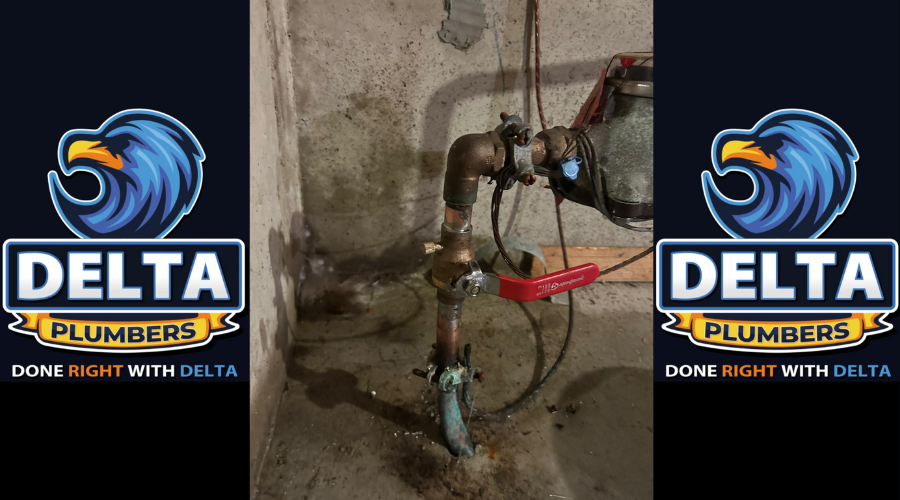Plumbing has played a crucial role in human civilization for thousands of years, evolving from simple drainage systems to the modern indoor plumbing we rely on today. The development of plumbing has been shaped by innovation, necessity, and advancements in technology. Canada’s plumbing history is deeply connected to global influences, particularly from ancient Rome and other pioneering civilizations. From aqueducts and lead pipes to modern copper and PVC systems, the journey of plumbing has revolutionized sanitation, hygiene, and daily living. This blog explores the history of Canadian plumbing, tracing its roots from ancient civilizations to contemporary advancements. We will uncover when indoor plumbing became widespread in Canada, the plumbing innovations of ancient Rome, and the materials used in Canadian homes throughout different eras. Join us as we dive into the history that shaped the way we access and manage water today.

Picture Source – Delta Plumbers
When Did Indoor Plumbing Come to Canada?
Indoor plumbing in Canada developed gradually over the 19th and 20th centuries. In the early days of settlement, most Canadians relied on outhouses and wells for their water needs. The introduction of indoor plumbing started in major cities like Toronto and Montreal in the mid-to-late 1800s, as municipal waterworks systems were developed.
By the early 1900s, running water and sewer systems became more common in urban areas, but it wasn’t until after World War II that most Canadian homes were equipped with modern indoor plumbing. Rural areas, however, lagged, and many homes in remote regions did not have access to indoor plumbing until the 1950s and 1960s. The increased focus on sanitation, hygiene, and advancements in plumbing technology contributed to the widespread adoption of indoor plumbing across the country.
During this period, innovations such as pressurized water systems, better sewage treatment plants, and plumbing codes ensured that homes had reliable and safe water access. The Canadian government also played a significant role by introducing infrastructure projects that improved plumbing accessibility across different provinces.
Also Read: Top 5 Plumbing Issues in Older Homes

Picture Source – Delta Plumbers
What Was Plumbing Like in Ancient Rome?
The Romans were pioneers in plumbing and sanitation, building one of the most sophisticated water supply and waste management systems of the ancient world. They constructed extensive aqueducts that transported clean water from distant sources into cities. These aqueducts supplied water to public fountains, baths, and private homes of the wealthy.
Roman plumbing included lead pipes, bronze valves, and terracotta sewage systems. The Romans also built large public baths and latrines that were connected to underground drainage systems, preventing waste from contaminating drinking water sources. Their ability to engineer pressurized water systems and drainage solutions set the foundation for modern plumbing principles.
The Romans also utilized cisterns and reservoirs to store water, ensuring a steady supply for large urban populations. Despite their advancements, the use of lead pipes contributed to health issues over time, something modern plumbing systems have worked to rectify by replacing lead with safer materials.
Also Read: How to Detect and Fix Hidden Water Leaks in Your Home

Picture Source – Delta Plumbers
What Ancient Civilization Had Modern Plumbing?
While Rome is often credited with advanced plumbing, other ancient civilizations also made significant contributions to plumbing and sanitation.
- The Indus Valley Civilization (3300-1300 BCE): Cities like Harappa and Mohenjo-Daro featured complex drainage systems, private wells, and indoor bathing areas. The civilization built covered sewer systems made of baked bricks, showcasing remarkable urban planning.
- Ancient Egypt (3000-1000 BCE): Egyptians developed early copper pipes to transport water within temples and palaces. They also had rudimentary drainage systems.
- Ancient Greece (800-146 BCE): The Minoans on the island of Crete developed terracotta pipes and flushing toilets in the palace of Knossos.
- China (2000 BCE and later): Early Chinese dynasties built elaborate irrigation and drainage systems, using bamboo pipes to transport water.
These civilizations laid the groundwork for the modern plumbing systems used today, demonstrating early knowledge of sanitation, water distribution, and waste management.
Also Read: Tankless Water Heater: Why You Should Upgrade

Picture Source – Delta Plumbers
What Year Did Most Homes Have Indoor Plumbing?
The timeline for the widespread adoption of indoor plumbing varies by country and region. In Canada, the progression followed these key milestones:
- Late 1800s: Indoor plumbing was introduced in major cities, primarily for the wealthy.
- Early 1900s: Municipal water and sewer systems became more common in urban areas.
- 1940s-1950s: Post-World War II, a construction boom led to the rapid expansion of plumbing in new homes.
- 1960s-1970s: Government programs helped bring plumbing to rural and remote areas.
- 1980s: Almost all homes in Canada had access to indoor plumbing.
By the 1970s, indoor plumbing was a standard feature in nearly all newly built homes across Canada, with rural areas catching up through infrastructure development. The increasing focus on hygiene, public health policies, and the demand for modern conveniences accelerated the transition towards fully plumbed homes.
Also Read: Routine Drain Cleaning: Why it is Essential for Your Home.

Picture Source – Delta Plumbers
What Type of Plumbing Was Used in 1970 in Canada?
In the 1970s, Canadian homes primarily used the following plumbing materials:
- Copper Pipes: The most common material for water supply lines due to its durability and resistance to corrosion.
- Galvanized Steel Pipes: Used in older homes but later replaced due to rusting and reduced water pressure.
- Cast Iron Drain Pipes: Commonly used for waste drainage, especially in apartment buildings and commercial properties.
- Polybutylene (PB) Pipes: Introduced in the late 1970s as a low-cost alternative but later discontinued due to failure risks.
- PVC (Polyvinyl Chloride) Pipes: Gained popularity for drain, waste, and vent (DWV) systems due to their lightweight and corrosion resistance.
The plumbing technology of the 1970s laid the groundwork for modern materials like PEX (cross-linked polyethylene), which became more widespread in later decades. The transition to safer and more durable materials improved water quality and system longevity.
Also Read: Top Plumbing Problems in Commercial Buildings and How to Solve Them

Picture Source – Delta Plumbers
What Did Romans Use Instead of Toilet Paper?
Ancient Romans did not have toilet paper as we know it today. Instead, they used a variety of alternatives, including:
- Tersorium: A sponge attached to a stick, which was rinsed in running water and reused.
- Pumice Stones: Rough stones were sometimes used for cleaning.
- Leaves and Moss: Natural materials were commonly used, especially by the lower classes.
- Ceramic Fragments (Pessoi): Flat pieces of pottery, sometimes inscribed with names, were used in public latrines.
Public latrines in Rome were communal, with benches that had openings for waste disposal and water channels for cleaning. Hygiene practices varied based on social class and access to clean water. Despite their resourcefulness, the lack of disposable hygiene products contributed to the spread of diseases.
Also Read: Best Plumbing Services in Ontario: What to Look For

Picture Source – Delta Plumbers
What Are Some Ancient Plumbing Facts?
Plumbing has evolved dramatically over thousands of years, but many ancient innovations still influence modern systems. Here are some fascinating plumbing facts:
- The world’s oldest known plumbing system dates back to the Indus Valley Civilization (c. 2500 BCE), with advanced drainage and bathing facilities.
- Roman aqueducts stretched over 260 miles, supplying millions of gallons of water daily.
- Ancient Greek plumbing included early showers, with water pressure created by gravity-fed systems.
- Medieval Europe saw a decline in plumbing innovation, leading to unsanitary conditions that contributed to disease outbreaks.
- The first flushing toilet was invented by Sir John Harington in 1596, though it did not become widely used until the 19th century.
- Thomas Crapper popularized the modern toilet in the late 1800s, improving plumbing fixtures and waste disposal systems.
- Canada’s plumbing codes are among the strictest in the world, ensuring safe and efficient water distribution.
Conclusion
From ancient Rome to modern Canadian homes, plumbing has come a long way. The Romans built sophisticated water supply systems that influenced global plumbing practices. Other ancient civilizations, like the Indus Valley, Greece, and China, also played crucial roles in the development of plumbing.
In Canada, indoor plumbing became standard throughout the 20th century, with advancements in materials and technology improving efficiency and sanitation. Today, Delta Plumbers continues the tradition of providing high-quality plumbing services, ensuring that modern homes benefit from the best innovations in plumbing history.
Understanding the past helps us appreciate the present and anticipate future advancements in plumbing. Whether you need repairs, installations, or maintenance, Delta Plumbers is here to keep your home’s plumbing running smoothly.









